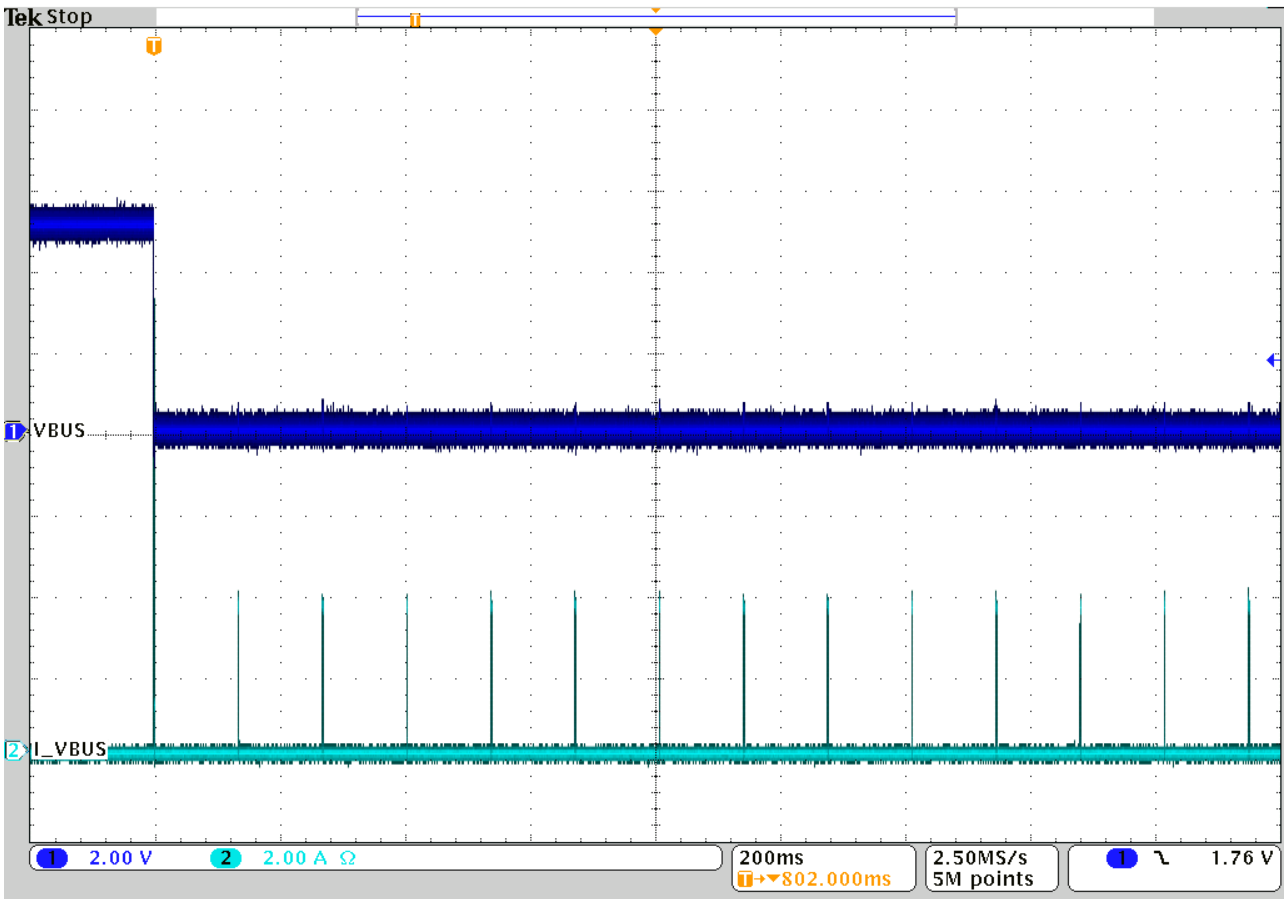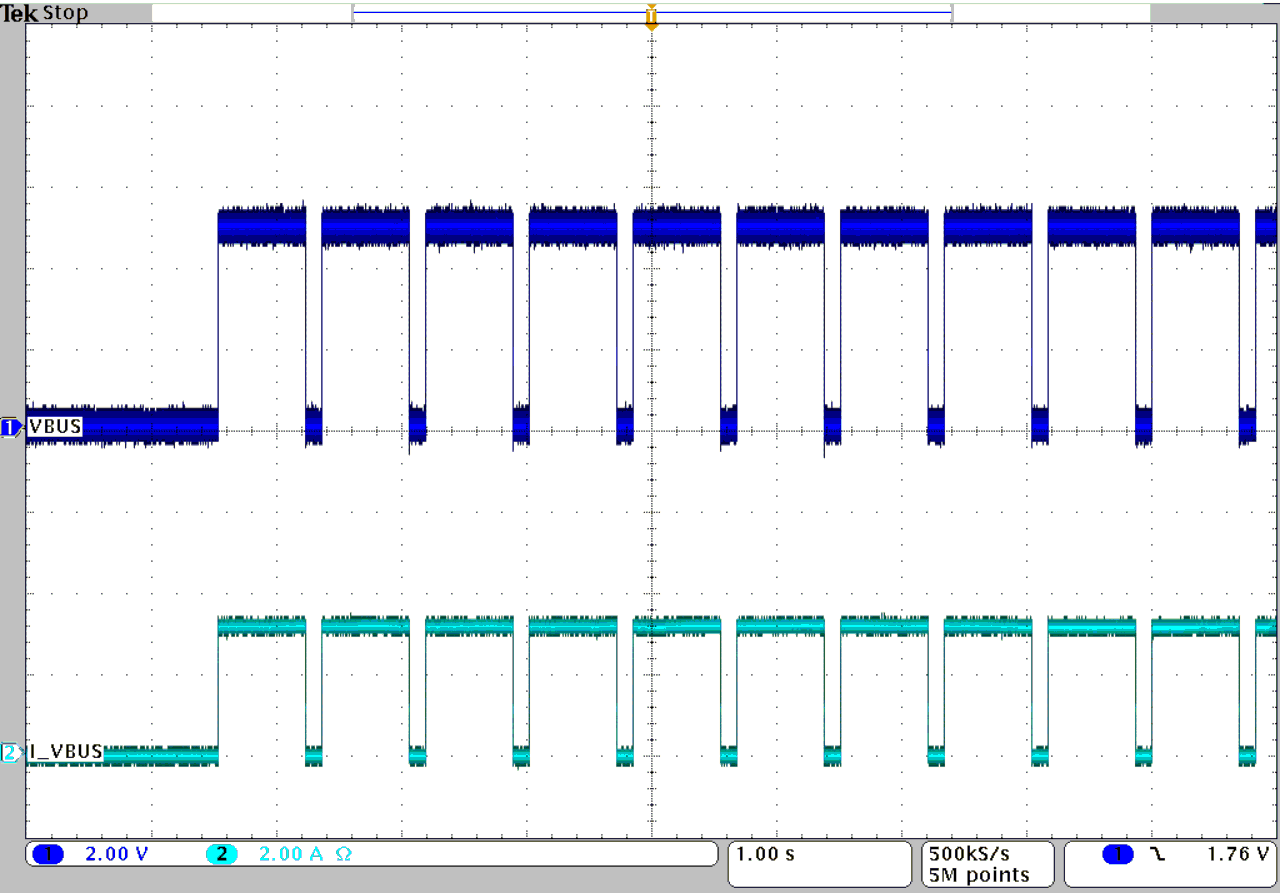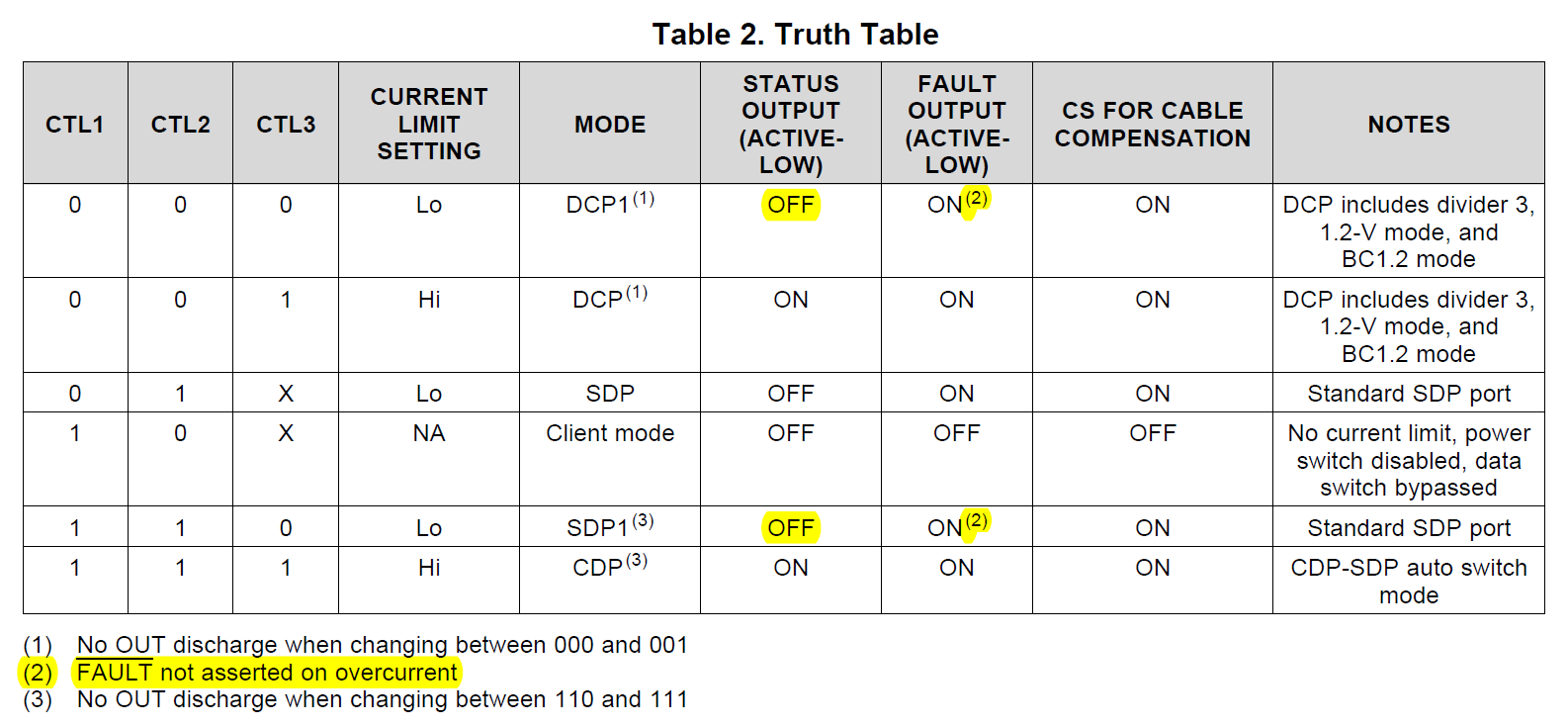-
検索結果
-
トピック: SPI通信のオーバーランエラーフラグについて
eUSCI A1でSPI通信(3線マスター)を実行しています。
受信割り込み処理で受信バッファのデータを読み出す前にオーバーランエラーフラグ(UCAxSTATWのUCOE)のON/OFFを判定したところ、常にオーバーランエラーフラグがONと判定されました。
デバッガ上で、受信割り込み処理でブレークをかけてレジスタの値を確認すると、オーバーランエラーフラグはON(=1)になっていることも確認しました。受信割り込み処理でテストポート出力を反転させてUCA1SOMIに入力される受信データと比較したところ、8クロック分の受信データが入力されるとテストポート出力も反転していたため、受信バッファのデータを読み出す前に受信バッファが上書きされていることは無いようでした。
また、受信バッファからRAMに移した受信データも設計通りの値になっていたため、SPI通信は正常に実行できていると考えています。
オーバーランエラーフラグがONになっている原因は何が考えられるのでしょうか?
DC-submoduleについて質問します。
今までに28069で、内蔵コンパレータによりPWM信号をPlusByPlus(CBC)で保護をかけていましたが、
28075(176pin)になり内蔵コンパレータが6モジュールとなり、ドキュメントでは接続信号名が理解できないので説明ドキュメントがあれば教えてください。
28069までは
Table 3-53. Digital Compare Trip Select (DCTRIPSEL) Field Descriptions
0000 TZ1 input
0001 TZ2 input
0010 TZ3 input
1000 COMP1OUT input
1001 COMP2OUT input
1010 COMP3OUT input
を選択すればよかったが、
<コード例>
EPwm1Regs.DCTRIPSEL.bit.DCAHCOMPSEL = DC_COMP1OUT;
EPwm1Regs.DCTRIPSEL.bit.DCBHCOMPSEL = DC_COMP3OUT;28075マニュアルでは、
SPRUHM9–October 2014 / The eCAP input signals are sourced from the Input X-BAR signals as shown in Figure 12-49.
入力信号名がTripin* となり1-12まであります。これが更にepwm x-barでマルチプレックスされているようで、ここの説明が見つかりませんでした。よろしくお願いします。
トピック: 標準ファイルがincludeエラーになる
「ccsv8」で別のPCからimportしたProjrctを「Debug build」すると、「stdint.h」「math.h」などが「cannot open source file」エラーになってしまいます。解決方法を教えてください。</p><p>ビルドしたエラーリストを添付いたします。
※添付ファイル名(txt、zip)が添付できないのでエラー出力の一部を下記にご連絡します。**** Build of configuration Debug for project F28075PowerPlatform-V0.03G6 ****
“C:\\ti\\ccs800\\ccsv8\\utils\\bin\\gmake” -k all <br /><br />Building file: “C:/ti/controlSUITE/device_support/F2807x/v210/F2807x_common/source/F2807x_Adc.c”
Invoking: C2000 Compiler<br />”C:/ti/ccs800/ccsv8/tools/compiler/ti-cgt-c2000_18.1.1.LTS/bin/cl2000″ -v28 -ml -mt –cla_support=cla1 –float_support=fpu32 –tmu_support=tmu0 –include_path=”/packages/ti/xdais” –include_path=”C:/ti/controlSUITE/device_support/F2807x/v210/F2807x_common” –include_path=”C:/ti/controlSUITE/device_support/F2807x/v210/F2807x_common/include” –include_path=”C:/ti/controlSUITE/device_support/F2807x/v210/F2807x_headers/include” –include_path=”C:/ti/controlSUITE/libs/math/IQmath/v160/include” –include_path=”C:/ti/controlSUITE/libs/math/FPUfastRTS/V100/include” –include_path=”C:/ti/ccsv8/tools/compiler/ti-cgt-c2000_18.1.1.LTS/include” –include_path=”C:/ti/ccsv6/tools/compiler/ti-cgt-c2000_6.4.6/include” –advice:performance=all –define=TARGET_F28075 –define=CPU1 –define=_DEBUG –define=LARGE_MODEL –define=ccs_c2k –undefine=TARGET_F28069 -g –diag_warning=225 –issue_remarks –verbose_diagnostics –quiet –preproc_with_compile –preproc_dependency=”F2807x_Adc.d_raw” “C:/ti/controlSUITE/device_support/F2807x/v210/F2807x_common/source/F2807x_Adc.c”>> Compilation failure
subdir_rules.mk:9: recipe for target ‘F2807x_Adc.obj’ failed
“C:/ti/controlSUITE/device_support/F2807x/v210/F2807x_headers/include/F2807x_device.h”, line 195: fatal error: cannot open source file “assert.h”#include <assert.h>^
1 catastrophic error detected in the compilation of “C:/ti/controlSUITE/device_support/F2807x/v210/F2807x_common/source/F2807x_Adc.c”.
Compilation terminated.
gmake: *** [F2807x_Adc.obj] Error 1
Building file: “C:/ti/controlSUITE/device_support/F2807x/v210/F2807x_common/source/F2807x_CpuTimers.c”
Invoking: C2000 Compiler
“C:/ti/ccs800/ccsv8/tools/compiler/ti-cgt-c2000_18.1.1.LTS/bin/cl2000″ -v28 -ml -mt –cla_support=cla1 –float_support=fpu32 –tmu_support=tmu0 –include_path=”/packages/ti/xdais” –include_path=”C:/ti/controlSUITE/device_support/F2807x/v210/F2807x_common” –include_path=”C:/ti/controlSUITE/device_support/F2807x/v210/F2807x_common/include” –include_path=”C:/ti/controlSUITE/device_support/F2807x/v210/F2807x_headers/include” –include_path=”C:/ti/controlSUITE/libs/math/IQmath/v160/include” –include_path=”C:/ti/controlSUITE/libs/math/FPUfastRTS/V100/include” –include_path=”C:/ti/ccsv8/tools/compiler/ti-cgt-c2000_18.1.1.LTS/include” –include_path=”C:/ti/ccsv6/tools/compiler/ti-cgt-c2000_6.4.6/include” –advice:performance=all –define=TARGET_F28075 –define=CPU1 –define=_DEBUG –define=LARGE_MODEL –define=ccs_c2k –undefine=TARGET_F28069 -g –diag_warning=225 –issue_remarks –verbose_diagnostics –quiet –preproc_with_compile –preproc_dependency=”F2807x_CpuTimers.d_raw” “C:/ti/controlSUITE/device_support/F2807x/v210/F2807x_common/source/F2807x_CpuTimers.c”>> Compilation failure<br />subdir_rules.mk:23: recipe for target ‘F2807x_CpuTimers.obj’ failed
“C:/ti/controlSUITE/device_support/F2807x/v210/F2807x_headers/include/F2807x_device.h”, line 195: fatal error: cannot open source file “assert.h”
#include <assert.h>1 catastrophic error detected in the compilation of “C:/ti/controlSUITE/device_support/F2807x/v210/F2807x_common/driverlib/can.c”.
Compilation terminated.
gmake: *** [can.obj] Error 1
Building file: “../cmdline.c”
Invoking: C2000 Compiler
“C:/ti/ccs800/ccsv8/tools/compiler/ti-cgt-c2000_18.1.1.LTS/bin/cl2000″ -v28 -ml -mt –cla_support=cla1 –float_support=fpu32 –tmu_support=tmu0 –include_path=”/packages/ti/xdais” –include_path=”C:/ti/controlSUITE/device_support/F2807x/v210/F2807x_common” –include_path=”C:/ti/controlSUITE/device_support/F2807x/v210/F2807x_common/include” –include_path=”C:/ti/controlSUITE/device_support/F2807x/v210/F2807x_headers/include” –include_path=”C:/ti/controlSUITE/libs/math/IQmath/v160/include” –include_path=”C:/ti/controlSUITE/libs/math/FPUfastRTS/V100/include” –include_path=”C:/ti/ccsv8/tools/compiler/ti-cgt-c2000_18.1.1.LTS/include” –include_path=”C:/ti/ccsv6/tools/compiler/ti-cgt-c2000_6.4.6/include” –advice:performance=all –define=TARGET_F28075 –define=CPU1 –define=_DEBUG –define=LARGE_MODEL –define=ccs_c2k –undefine=TARGET_F28069 -g –diag_warning=225 –issue_remarks –verbose_diagnostics –quiet –preproc_with_compile –preproc_dependency=”cmdline.d_raw” “../cmdline.c”>> Compilation failure<br />subdir_rules.mk:107: recipe for target ‘cmdline.obj’ failed
“../cmdline.c”, line 24: fatal error: cannot open source file “stdint.h”
#include <stdint.h>セキュリティ機能について教えて下さい。
外付けNORフラッシュを使用したことがないため、よく解かりません。
ルネサス製マイコンの様に、エンドユーザーのROMイメージの不正読み出しを
防ぐ様な機能でしょうか?詳しく教えて下さい。トピック: BQ24616の設定電流 他について
いつもお世話になっております。
BQ24616について問い合わせがあります。
【問い合わせ内容】
1. 現行の充電電流はACアダプタの容量等もあり600mA程度で充電していますが、
このICの設定電流のMAXは10Aとなっています。
設定方法は、Icharge=Viset1/(20xRsr)となっており、Rsrはデフォルトで10mΩを推奨しています。
この時、Viset1≒0.12Vとなりますが特に問題ないでしょうか。
10Aからあまりにも低すぎる設定電流なのでちょっと気になります。
また、データシートの表2に充電電流をパラメータ(2A~10A)にインダクタとコンデンサの容量の
記載がありますが、充電電流が600mAの時にもこのLCの値は得られますでしょうか。2.BQ24616、BQ24610の差異を教えてください
JEITAガイドラインに対応しているかしていないかの差異で良いでしょうか。
パッケージ、ピン配置は同一となっています。3.BQ24617は、セル数が5個までということでしょうか。
セル数が2個でJEITAは不要であれば、BQ24617の選択で良いでしょうか。
以上どうぞ、宜しくお願い致します。
MSP430F5529 LaunchPadをPCに接続して
以下の様に操作をしているのですが、USBを認識してくれません。
対処方法をお教えください。①、PCのUSBポートにMSP430F5529 LaunchPadの評価ボードを接続
②、TI のホームページからCCSの最新バージョン(8.1.0)をダウンロードして起動
③、CCSを立ち上げて、プログラムをコンパイルリンクしてUSBに接続した評価ボードへダウンロードし、
CONNECT TARGETボタンを押してUSBの接続を確認
④、MSP430F5529 LaunchPadの BSLキーを長押ししたが、以下のエラーがPCに表示されてUSBを認識できない
⑤、PC側のデバイスマネージャで、MSP430のUSBドライバーがインストールされて認識されている事を確認以上、宜しくお願い致します。
トピック: 未使用ピンについて
SN74LVC8T245PW
SN74ALVC164245DL・上記ICの未使用のI/Oポートは、どのように処理すれば良いでしょうか。
(A側 及び B側のI/Oポートの両方をGNDに接続でしょうか?)
なお、上記ICは複数使用する予定ですが、方向(DIR)を制御するものと、
方向(DIR)を HI(A→B)または LOW(B→A)に固定して使用するものがあります。

 フォーラム検索:page
フォーラム検索:page

